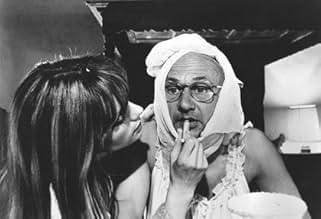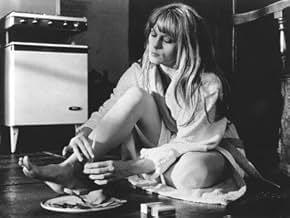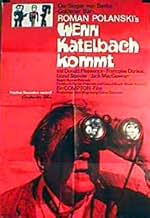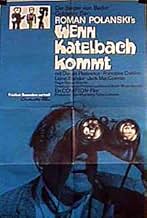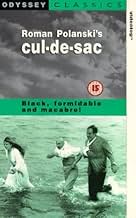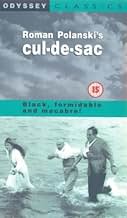IMDb रेटिंग
7.0/10
15 हज़ार
आपकी रेटिंग
अपनी भाषा में प्लॉट जोड़ेंIn search of help, two wounded gangsters on the run find refuge in the secluded castle of a feeble man and his wife; however, under the point of a gun, nothing is what it seems.In search of help, two wounded gangsters on the run find refuge in the secluded castle of a feeble man and his wife; however, under the point of a gun, nothing is what it seems.In search of help, two wounded gangsters on the run find refuge in the secluded castle of a feeble man and his wife; however, under the point of a gun, nothing is what it seems.
- निर्देशक
- लेखक
- स्टार
- 1 BAFTA अवार्ड के लिए नामांकित
- 1 जीत और कुल 1 नामांकन
Jacqueline Bisset
- Jacqueline
- (as Jackie Bisset)
फ़ीचर्ड समीक्षाएं
Finally had the opportunity to watch this film. I love Roman Polanski's work. The first two films of The Apartment trilogy are phenomenal. Even his recent stuff is so good (I'm talking especially about Carnage). This is a film he worked on in between Repulsion and Rosemary's Baby and going in I had no idea what it was about. After watching I don't think its among Polanski's best but still enjoyable and pretty damn frenetic like most of his work at the time.
The film follows a gangster and his dying partner who take refuge in a castle out in an island. On this island lives quite a neurotic man and his girlfriend and they kind of have to give into the whims of their captor. In a way push comes to shove and things get hectic between the trio and others coming onto the island. Its hard to explain this film fully giving it justice without spoiling. While the film has flaws and isn't as memorable as some of his others that came out at the same time.
It doesn't really tap into fear and paranoia like Rosemary's Baby and Repulsion; its another thing thematically. I think the comedic aspect of the film kind of hurts it from being one of Polanski's finer works. I think Polanski knows how to tap into fear, anxiety, paranoia and this film is pretty void of that. It's nice seeing Donald Pleasance in something so different prior to his Halloween days.
Overall, its worth a watch for people who really like Polanski's work although he is capable of much better. Its still an alluring experience as with most of his work. It doesn't quite feel as claustrophobic a film as it could be (with the title and his other work). I might go on a bit of a Polanski binge and watch a bunch of other stuff I haven't seen. Or, revisit some of his best which should be fun.
7/10
The film follows a gangster and his dying partner who take refuge in a castle out in an island. On this island lives quite a neurotic man and his girlfriend and they kind of have to give into the whims of their captor. In a way push comes to shove and things get hectic between the trio and others coming onto the island. Its hard to explain this film fully giving it justice without spoiling. While the film has flaws and isn't as memorable as some of his others that came out at the same time.
It doesn't really tap into fear and paranoia like Rosemary's Baby and Repulsion; its another thing thematically. I think the comedic aspect of the film kind of hurts it from being one of Polanski's finer works. I think Polanski knows how to tap into fear, anxiety, paranoia and this film is pretty void of that. It's nice seeing Donald Pleasance in something so different prior to his Halloween days.
Overall, its worth a watch for people who really like Polanski's work although he is capable of much better. Its still an alluring experience as with most of his work. It doesn't quite feel as claustrophobic a film as it could be (with the title and his other work). I might go on a bit of a Polanski binge and watch a bunch of other stuff I haven't seen. Or, revisit some of his best which should be fun.
7/10
As 'Cul-de-sac' was Polanski's first movie after his brilliant psychological thriller 'Repulsion' it can't help but be a slight disappointment. Even so, I thought it was an interesting movie and I found it to be much more enjoyable than his next one the totally unfunny spoof 'The Fearless Vampire Killers'. 'Cul-de-sac' is quite difficult to catergorise. In some ways it reminded me of Pinter's 'The Birthday Party' (filmed much later than this but originally staged in the late 1950s), in others of Jack Hill's cult favourite 'Spider Baby' (made earlier but not really released until afterwards), and you could almost see it as prefiguring 'Performance' (old school gangsters meet the new world of the swinging 1960s). But really it quite an odd and unique black comedy. It may not be 100% successful, and it does have a few dull spots, but overall it's worth tracking down if you want to see something different. The main reason it succeeds for me is the unusual location of Lindisfarne, England (which I have visited), and the performances of Donald Pleasence, Francoise Dorleac and Lionel Stander. Pleasence was one of Britain's most underrated character actors, the beautiful and doomed Dorleac had appeared alongside Jean-Paul Belmondo in the entertaining thriller 'That Man From Rio', and Standish, who later appeared in movies by Leone and Spielberg, is best remembered as Max, the craggy manservant on the popular 1980s TV show 'Hart To Hart'. All three are excellent in this movie, and their interaction make it fascinating viewing. The supporting cast also includes Jack MacGowran ('The Exorcist') and an early appearance by 1970s sex symbol Jacqueline Bisset. 'Cul-de-sac' is without a doubt Polanski's most underrated movie, and fans of the unusual and the off beat will enjoy it very much. A DVD with a commentary from Polanski would would be wonderful. Any chance?
A diminutive artist (Donald Pleasence) lives with his much-younger French wife (Françoise Dorléac) in a castle on a tidal island in northern England. When a gruff gangster (Lionel Stander) shows up on their doorstep havoc ensues. Iain Quarrier, William Franklyn and a young Jacqueline Bisset show up for peripheral parts.
"Cul-de-Sac" (1966) is one of Roman Polanski's early experiments, a freestyle B&W psychological crime dramedy that takes elements of "The Damned" (1963), "Touch of Evil" (1958) and "A Streetcar Named Desire" (1951) and mixes them with black humor and the theme of the later "Straw Dogs" (1971). Jack Nicholson cited it as his favorite film, which makes sense when you consider Nicholson's "The Shooting" (1966). In tone, it's the precursor to Altman flicks like "The Long Goodbye" (1973).
There's such an improvisational feel that one wonders what the point is: French girls are neurotic and promiscuous? British artists are wussies? Those who live by the gun will die by the gun? No matter how much a person tries to escape the world to focus on fulfilling his/her art (whatever that might be), the corruption of the world will come knocking on your door and might even share your bed? That even a finely cultured man will resort to his primordial nature if backed into a corner?
The film obviously has its partisans, who deem it a masterpiece. There are some interesting technical things going on, like the 7.5 minute scene on the beach, which was one of the longest continuous sequences in cinema up to that point. But the characters are oddball and unlikable while the story is meandering and dramatically dull. Yet the locations, the cast and the themes are to die for, not to mention the eccentricities.
The film runs 1 hour, 52 minutes, and was shot at Holy Island of Lindisfarne, off the coast of northeastern England.
GRADE B-/C+
"Cul-de-Sac" (1966) is one of Roman Polanski's early experiments, a freestyle B&W psychological crime dramedy that takes elements of "The Damned" (1963), "Touch of Evil" (1958) and "A Streetcar Named Desire" (1951) and mixes them with black humor and the theme of the later "Straw Dogs" (1971). Jack Nicholson cited it as his favorite film, which makes sense when you consider Nicholson's "The Shooting" (1966). In tone, it's the precursor to Altman flicks like "The Long Goodbye" (1973).
There's such an improvisational feel that one wonders what the point is: French girls are neurotic and promiscuous? British artists are wussies? Those who live by the gun will die by the gun? No matter how much a person tries to escape the world to focus on fulfilling his/her art (whatever that might be), the corruption of the world will come knocking on your door and might even share your bed? That even a finely cultured man will resort to his primordial nature if backed into a corner?
The film obviously has its partisans, who deem it a masterpiece. There are some interesting technical things going on, like the 7.5 minute scene on the beach, which was one of the longest continuous sequences in cinema up to that point. But the characters are oddball and unlikable while the story is meandering and dramatically dull. Yet the locations, the cast and the themes are to die for, not to mention the eccentricities.
The film runs 1 hour, 52 minutes, and was shot at Holy Island of Lindisfarne, off the coast of northeastern England.
GRADE B-/C+
Cul-de-sac is a very beautiful black and white movie. It belongs to the lightweight category. The story is weird in an entertaining way, often amusing and sad at once. If the director tried to be willingly shallow, he was very successful. And I do not mean that ironically but say it with awe.
The place is Holy Island, on the east coast of Northern England. It actually gets cut off with the tide. Polanski makes very good use of the location and was very lucky with the casting. All characters are rather detestable in a detached sort of way. Donald Pleasance gives the performance of his life as the emasculated, utterly humiliated owner of the castle on the island. The other two main characters are the brisk yet elf like Françoise Dorléac and Lionel Stander as a gruff, brutal gangster. There is a very strange, truly unique chemistry between Dorléac and Stander. Dorléac does something to Stander. «We call dees a bicycle», she says gleefully with her funny accent, and it nearly knocks me off my chair every time I see that well filmed, suspenseful scene. I wont tell you what «de bicycle» is it may need parental guidance to watch it but does not belong to the restrictable area. Cul-de-sac has a very memorable musical score.
The place is Holy Island, on the east coast of Northern England. It actually gets cut off with the tide. Polanski makes very good use of the location and was very lucky with the casting. All characters are rather detestable in a detached sort of way. Donald Pleasance gives the performance of his life as the emasculated, utterly humiliated owner of the castle on the island. The other two main characters are the brisk yet elf like Françoise Dorléac and Lionel Stander as a gruff, brutal gangster. There is a very strange, truly unique chemistry between Dorléac and Stander. Dorléac does something to Stander. «We call dees a bicycle», she says gleefully with her funny accent, and it nearly knocks me off my chair every time I see that well filmed, suspenseful scene. I wont tell you what «de bicycle» is it may need parental guidance to watch it but does not belong to the restrictable area. Cul-de-sac has a very memorable musical score.
Two gangsters on the run hide out in a isolated castle that is occupied by Plesance and Dorleac. The two share a rather bizarre passive, aggressive relationship that quickly disintegrates when interrupted by the strangers. Eventually a even more bizarre bonding develops between the couple and Stander, one of the gangsters. Very, very intriguing psychological drama with wonderfully subversive elements lurking just beneath the surface.
Polanski makes full use of the castle showing it's dark, shadowy interior as a sort of symbolic equation to the dark recesses of the human mind. The characters all have their odd traits yet are still believable and compelling to watch. Wonderfully photographed with a strong visual style that really gives this film a distinct look and personality.
Stander, who is probably best known as Max on the old HART TO HART series, has one of his finest roles. He plays a brute that mixes both savage and human traits all at the same time. Plesance though is astounding, playing a truly pathetic character that is simply unforgettable
Polanski makes full use of the castle showing it's dark, shadowy interior as a sort of symbolic equation to the dark recesses of the human mind. The characters all have their odd traits yet are still believable and compelling to watch. Wonderfully photographed with a strong visual style that really gives this film a distinct look and personality.
Stander, who is probably best known as Max on the old HART TO HART series, has one of his finest roles. He plays a brute that mixes both savage and human traits all at the same time. Plesance though is astounding, playing a truly pathetic character that is simply unforgettable
क्या आपको पता है
- ट्रिवियाRoman Polanski shot 16 takes of the scene in which Lionel Stander drinks a pint of milk.
- गूफ़When Dickie is pushing the car, the shadow of the camera and the cameraman can be seen on him.
- इसके अलावा अन्य वर्जनThe VHS version released in Brazil by Globo Vídeo has exactly 100 minutes.
- कनेक्शनFeatured in Le ciné-club de Radio-Canada: Film présenté: Cul-de-sac (1975)
टॉप पसंद
रेटिंग देने के लिए साइन-इन करें और वैयक्तिकृत सुझावों के लिए वॉचलिस्ट करें
विवरण
- रिलीज़ की तारीख़
- कंट्री ऑफ़ ओरिजिन
- आधिकारिक साइट
- भाषा
- इस रूप में भी जाना जाता है
- Ćorsokak
- फ़िल्माने की जगहें
- उत्पादन कंपनियां
- IMDbPro पर और कंपनी क्रेडिट देखें
बॉक्स ऑफ़िस
- दुनिया भर में सकल
- $1,500
- चलने की अवधि
- 1 घं 52 मि(112 min)
- रंग
- पक्ष अनुपात
- 1.66 : 1
इस पेज में योगदान दें
किसी बदलाव का सुझाव दें या अनुपलब्ध कॉन्टेंट जोड़ें


